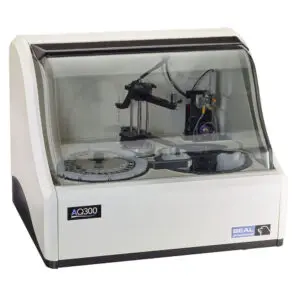Product Overview:
The SEAL AQ300 discrete analyzer offers the same benefits as the AQ400 discrete analyzer in a smaller footprint and with lower sample throughput, making it the ideal solution for laboratories with limited space and smaller workloads. The AQ300 is the direct replacement to the AQ1 discrete analyzer, keeping the low profile while offering improved ease-of-maintenance, a dedicated aspiration wash bath, reagent-level detection, increased throughput, and more.
Designed specifically for nutrient analysis on environmental samples, the AQ300 can measure many different parameters from one sample. Samples are read in an optically pure quartz cuvette to ensure the best possible reproducibility and lowest detection limits.
Why Select the AQ300:
Automation
- True unattended operation with the ability to run overnight
- Automated standard preparation and dilution of over-range samples
- True automated sample blanking for background color correction
- Automated sample spiking
Efficiency
- Ultra-low reagent consumption
- Ability to add samples after the run has started
- Easy maintenance & easy-change syringe
- Small footprint saves bench space real estate
Compliance
- No carryover or cross-contamination
- Standard 10 mm quartz cuvette
- Lower detection limits
- Chemical reaction brought to full completion emulating manual and segmented flow methods
Support
- Visual manuals and descriptive checklists
- Immediate support available from SEAL chemists via email, phone, screenshare, or video call
- In-depth training during installation
- Guides and webinars available for continued learning
Highlights of the AQ300:
Lower Detection Limits & Higher Reproducibility
An optically pure quartz cuvette provides a 10mm pathlength for maximum sensitivity and lower detection limits. Quartz is superior to styrene for sample analysis, ensuring excellent precision.
Minimal Reagent Usage
SEAL discrete analyzers use just 20 - 400 μL of reagent per test, lowering reagent costs and consumption as well as potential hazardous waste. On-board reagent cooling keeps reagents fresh through long testing periods, and built-in reagent level sensors ensure sufficient volumes for the tests before the run starts. Expiration dates are tracked in the software to remind analysts when it’s time to remake a solution.
Inexpensive Consumables
With detection taking place in a 10 mm flow-through quartz cuvette rather than in reaction wells, consumable costs are significantly lowered as reaction wells are not used in the optical read. Constant heating and a programmable reaction time ensure reactions reach completion before transfer from the reaction well to the cuvette.
Cadmium Reduction for Wider Matrix Compatibility
All SEAL discrete analyzers can run all types of nitrate reduction for colorimetric analysis of nitrate. Our most popular method is cadmium reduction due to the low cost and ability to handle a wide-range of sample types including wastewater, drinking water, industrial, and seawater samples. With cadmium reduction, all hazardous waste is contained in solid form in the cadmium coil for easier, safer disposal, rather than liquid form in other reduction methods. The cadmium coil can be regenerated in-line automatically, saving valuable analyst time.
Eliminate cross-contamination
A feature unique to SEAL discrete analyzers, our probe washer moves with the sample probes wiping the probe clean before moving to a new location, eliminating cross-contamination of samples, reagents, and diluents.
